Silver coins offer a reliable investment avenue amid economic uncertainty‚ providing a tangible asset with intrinsic value. They blend history‚ versatility‚ and potential for growth‚ appealing to both investors and collectors.
1.1 Historical Significance of Silver Coins
Silver coins have served as a cornerstone of global finance for centuries‚ tracing back to ancient civilizations. Their enduring value lies in their historical and cultural significance‚ often symbolizing wealth and power. From ancient Lydia to modern bullion‚ silver coins have evolved‚ offering both monetary and collectible appeal. Their historical roots enhance their allure for investors and historians alike.
1.2 Why Invest in Silver Coins?
Silver coins are a tangible asset with intrinsic value‚ offering a hedge against inflation and market volatility. They provide diversification in investment portfolios and are accessible to both seasoned investors and newcomers. With growing industrial demand and limited supply‚ silver coins present a unique opportunity for long-term growth and financial security in an uncertain economic landscape.
Understanding the Value of Silver Coins
Silver coins hold inherent value due to their silver content‚ offering stability and a tangible asset. Their worth is influenced by both bullion and collectible appeal.
2.1 Intrinsic Value vs. Numismatic Value
The intrinsic value of silver coins is determined by their silver content and current market price‚ providing a base worth. Numismatic value‚ however‚ considers rarity‚ condition‚ and historical significance‚ often exceeding intrinsic worth. This distinction helps investors decide whether they prioritize the metal’s value or the coin’s collectible appeal‚ impacting both short-term gains and long-term appreciation potential.
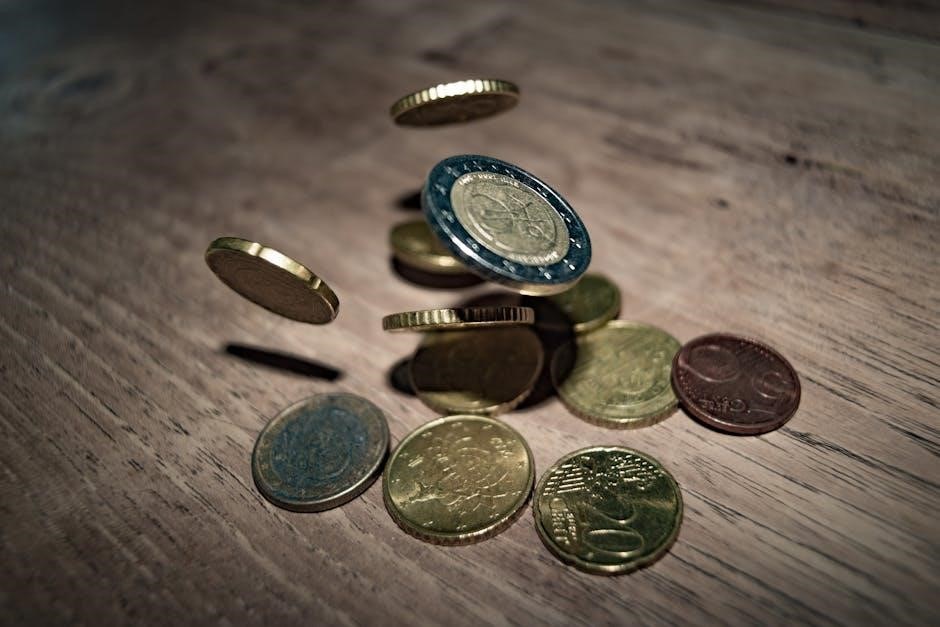
2.2 Factors Affecting Silver Coin Prices
Silver coin prices are influenced by supply and demand‚ industrial demand‚ economic trends‚ and geopolitical events. Market speculation‚ production costs‚ and currency fluctuations also play a role. Central banks’ policies and inflation rates can impact prices‚ while global events may cause price volatility. Understanding these factors helps investors make informed decisions in the dynamic silver market.
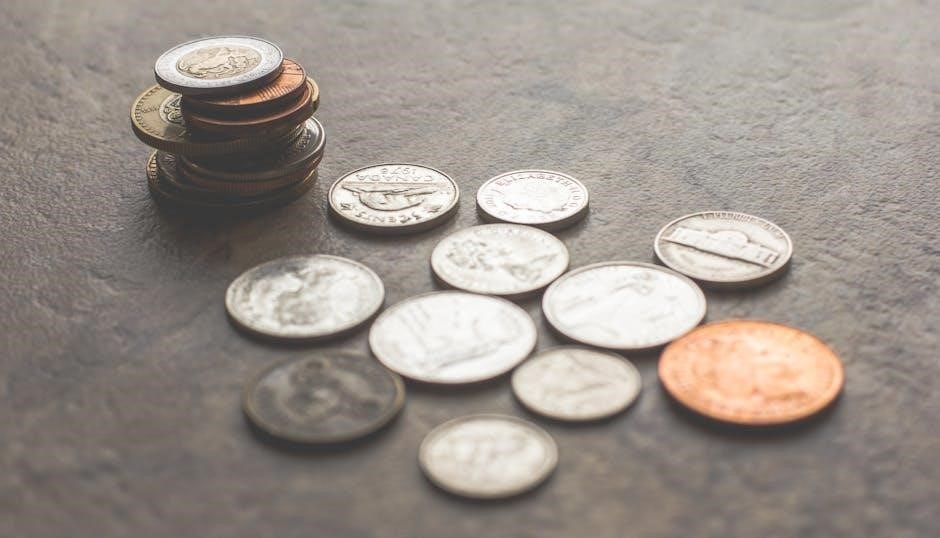
Popular Types of Silver Coins for Investment
Investors favor silver coins like the American Silver Eagle and Canadian Silver Maple Leaf for their high purity and aesthetic appeal‚ making them highly sought after.
3.1 American Silver Eagle
The American Silver Eagle‚ introduced in 1986‚ is one of the most recognized silver coins globally. Struck from 99.9% pure silver‚ it features the iconic Walking Liberty design. As a U.S. Mint product‚ it carries legal tender status and is highly sought after for its numismatic and investment value. Its popularity stems from its purity‚ design‚ and liquidity‚ making it a cornerstone for silver investors worldwide.
3.2 Canadian Silver Maple Leaf
The Canadian Silver Maple Leaf‚ minted by the Royal Canadian Mint since 1988‚ is known for its 99.99% silver purity. It features the iconic maple leaf and Queen Elizabeth II. Its high purity‚ unique design‚ and global recognition make it a valuable and liquid investment option‚ appealing to investors and collectors seeking a reliable and aesthetically pleasing asset.
3.3 Other Notable Silver Coins
Beyond the Eagle and Maple Leaf‚ other notable silver coins include the Australian Silver Kookaburra‚ Chinese Silver Panda‚ and Mexican Silver Libertad. These coins are prized for their unique designs and high silver content‚ making them attractive to investors and collectors. They offer diversity and cultural appeal‚ enhancing any investment portfolio with their distinct artistic and historical significance.
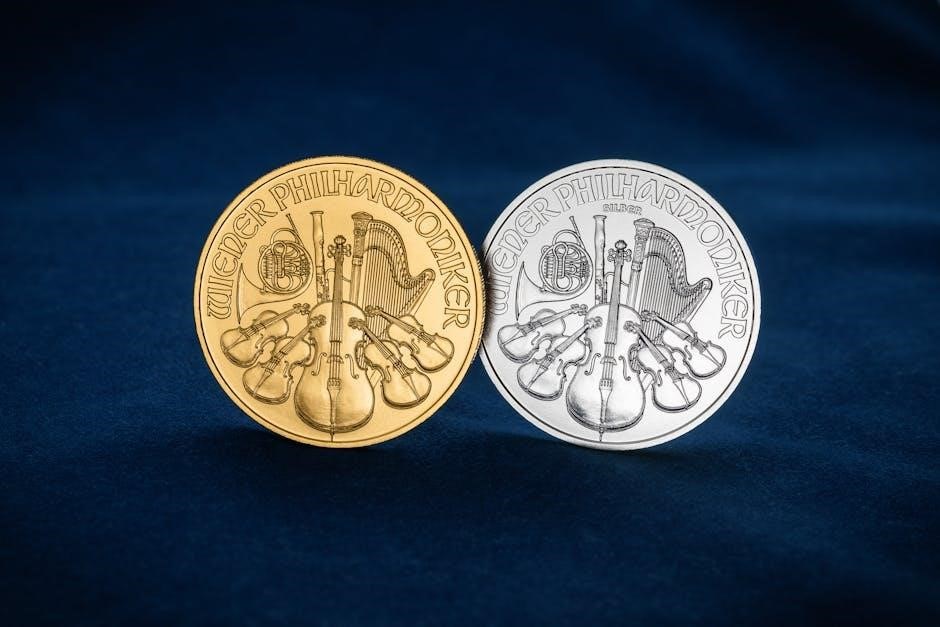
Investment Strategies for Silver Coins
Investors can adopt strategies like diversification and dollar-cost averaging to mitigate risks and capitalize on silver’s potential. These approaches help build a resilient and balanced portfolio.
4.1 Diversification in Your Portfolio
Diversification is a key strategy for managing risk in silver coin investments. By allocating assets across various silver coins‚ bullion‚ and other precious metals‚ investors reduce dependency on a single asset. This approach balances potential losses and gains‚ enhancing overall portfolio resilience. Diversification also allows investors to capitalize on different market trends and economic conditions‚ ensuring a more stable and growth-oriented investment journey over time.
4.2 Dollar-Cost Averaging in Silver Investments
Dollar-cost averaging is a strategic approach to silver investing‚ where fixed amounts are invested at regular intervals‚ regardless of market conditions. This method reduces exposure to price volatility‚ as investments are spread over time. It eliminates the need to time the market and creates a disciplined investment process‚ making it ideal for risk-averse investors seeking steady growth in their silver coin portfolios over the long term.

Risks and Challenges in Silver Coin Investment
Silver coin investments carry risks like market volatility‚ liquidity challenges‚ and storage concerns. Investors may face losses if prices drop or if coins lose numismatic value over time.
5.1 Market Volatility
Silver coin prices can fluctuate rapidly due to market dynamics‚ geopolitical events‚ and economic shifts. This volatility may lead to significant gains or losses‚ making it a high-risk investment. Investors must stay informed about global trends and economic indicators to navigate price swings effectively. Diversification and long-term strategies can help mitigate the impact of market instability on silver coin investments.
5.2 Liquidity and Storage Concerns
Silver coins are generally liquid‚ but selling large quantities quickly can impact prices. Storage poses challenges‚ requiring secure‚ protective environments to prevent damage or theft. Investors often opt for home safes‚ bank vaults‚ or specialized storage services. Proper insurance coverage is essential to safeguard against loss or damage‚ ensuring peace of mind for valuable silver coin collections.
Where to Buy Silver Coins
Reputable online dealers‚ local coin shops‚ and auction houses offer silver coins. Ensure secure transactions and authenticity by choosing trusted sellers with strong customer reviews and guarantees.
6.1 Reputable Dealers and Online Platforms
Investors should purchase silver coins from trusted dealers like APMEX‚ JM Bullion‚ or SD Bullion. Online platforms such as eBay and specialized coin shops also offer verified products. Always research sellers‚ check reviews‚ and ensure secure payment methods to avoid fraud. Reputable dealers provide authenticity guarantees‚ ensuring your investment is genuine and of high quality.
6.2 Auction Houses and Specialty Stores
Auction houses like Sotheby’s and Christie’s offer rare silver coins‚ often at competitive prices. Specialty stores‚ such as local coin shops and antique dealers‚ provide unique finds. However‚ be cautious of high premiums and authenticity. Always verify coin grades through third-party services like PCGS or NGC to ensure value and legitimacy in your investment.

Tax Implications of Silver Coin Investments
Silver coin investments are subject to capital gains tax. Reporting requirements vary by jurisdiction‚ and proper documentation is essential. Seek professional advice to optimize tax outcomes;
7.1 Capital Gains Tax on Silver Coins
Capital gains tax applies to profits from selling silver coins. Rates depend on ownership duration‚ with short-term gains taxed higher than long-term. Proper documentation of purchase and sale prices is essential for accurate tax calculations. Investors should consult tax professionals to ensure compliance and optimize their tax obligations‚ as rules may vary by jurisdiction and investment type.
7.2 Reporting Silver Investments for Tax Purposes
Accurate reporting of silver investments is crucial for tax compliance. Investors must report gains or losses on silver coins when sold. Documentation of purchase and sale details‚ including dates and amounts‚ is essential. Silver coins are treated as capital assets‚ and profits are subject to capital gains tax. Underreporting can lead to penalties‚ so maintaining detailed records is vital for proper tax filing.
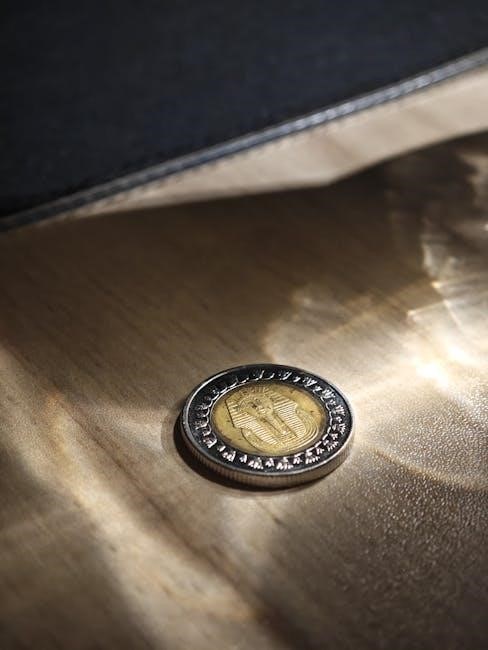
Storing and Securing Silver Coins
Silver coins require secure storage to protect against theft and damage. Use fireproof safes‚ protective cases‚ or specialized albums to maintain their condition and value over time.
8.1 Safe Storage Options
Secure storage is crucial to protect silver coins from damage or theft; Consider using fireproof safes‚ protective cases‚ or albums designed for coins. Store them in a cool‚ dry place to prevent tarnishing. For added security‚ use a safe deposit box at a bank or a highly rated home safe. Ensure storage locations remain private to avoid attracting unwanted attention.
8.2 Insurance for Your Silver Coin Collection
Insuring your silver coin collection is essential to protect against loss‚ theft‚ or damage. Opt for specialized insurance policies designed for precious metals or rare collectibles. Ensure the policy covers the coins’ full value‚ including any numismatic worth. Regularly update appraisals to reflect current market values. Compare insurance providers to find the best coverage options for your investment.
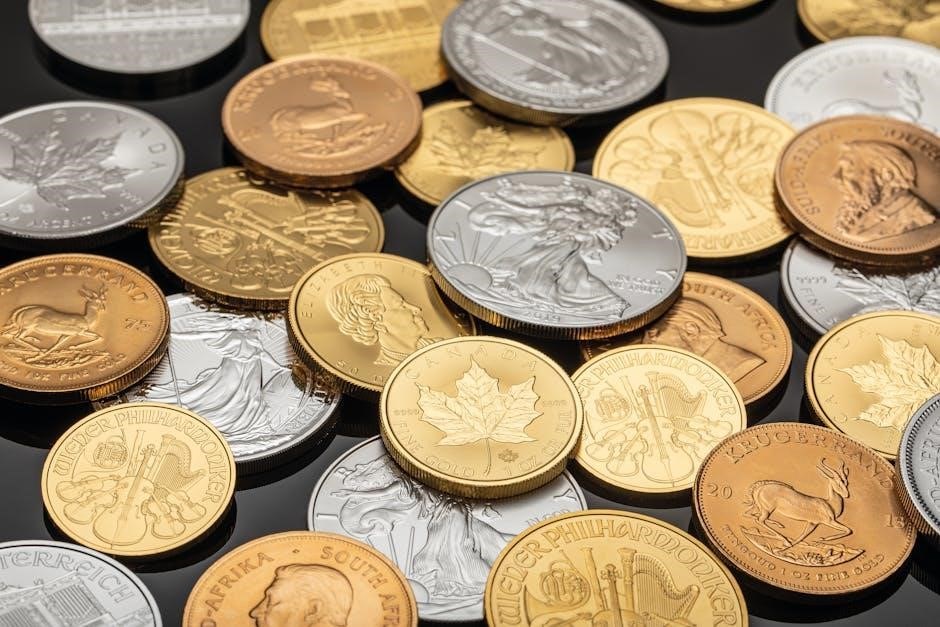
The Future of Silver Coin Investments
Silver coins are poised for growth due to increasing industrial demand and inflationary pressures. Their dual role as investments and collectibles ensures long-term appeal and stability.
9.1 Growing Demand for Silver
The demand for silver is rising due to its increasing use in industrial applications‚ renewable energy technologies‚ and medical fields. As industries expand‚ silver’s conductivity and durability make it indispensable. Additionally‚ growing investor interest in precious metals as a hedge against inflation further drives demand‚ positioning silver as a strategic investment with strong growth potential.
9.2 Impact of Economic Trends on Silver Prices
Economic trends significantly influence silver prices‚ as the metal serves both as an industrial commodity and a safe-haven asset. Inflation‚ recession fears‚ and geopolitical instability often drive investors to silver‚ boosting its value. Conversely‚ economic growth may reduce demand for safe assets‚ affecting prices. These dynamics highlight silver’s sensitivity to global economic shifts and market sentiment.
Silver coins are a timeless investment‚ blending historical significance with modern portfolio strength. They appeal to both investors and collectors. Consider thorough research and diversification for a robust portfolio. Stay informed to make wise decisions.
10.1 Best Practices for Silver Coin Investors
Thorough research and diversification are key to successful silver coin investments. Purchase from reputable dealers to ensure authenticity. Stay informed about market trends and economic factors. Secure storage and proper insurance are essential for protecting your collection. Avoid common mistakes like emotional buying and focus on long-term goals. Regular portfolio reviews and dollar-cost averaging can enhance investment stability.
10.2 Avoiding Common Mistakes
Investors should avoid buying counterfeit coins by ensuring purchases from reputable dealers. Neglecting proper storage and insurance can lead to losses. Overpaying for coins due to emotional decisions is a common error. Failing to research market trends and misunderstanding tax implications can harm returns. Avoid chasing short-term price swings and focus on long-term strategies for steady growth.